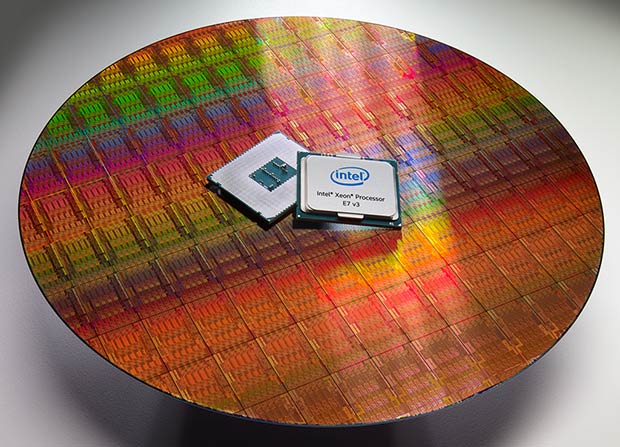Intel Launches Xeon E7-8800 and E7-4800 v3 Processor Families
Our Summary and Conclusion
All Intel Xeon E7-8800 / 4800 series processors utilize the same die, from the top-of-the-line advanced 18 core variants on down to the eight-core basic model.
We should point out, however, that while some processors will obviously have a significant number of disabled cores and wasted silicon, some of the processors with fewer cores will still have the same 45MB of cache enabled as higher-end parts.
Intel has also simplified its product stack and reduced the number of SKUs over the previous generation by 50%. The 16 – 18 core Xeon E7-8800 series processors in the advanced stack all support up to an 8-socket configuration. The 8 – 14 core standard and basic parts only support up to 4 sockets.
The frequencies, cache configurations, and TDPs of most of the Xeon E7-8800 / 4800 series processors is outlined in the slide above. The E7-8890 v3 HPC part sits at the top with a full 18-cores, 45MB of cache, and clock speed of 2.5GHz with a 165W TDP. The 8-core E7-4809 v3 is the lowest-power standard part at 115 watts, with the fewest number of cores, but there is also an 18-core part targeted at HPC applications (the E7-8800L v3) with a similar TDP, though it has similar clocks.
Ultimately, the Intel Xeon E7-8800 / 4800 series processors offer more cores, and more advanced cores than the previous generation, within a similar power envelope. The v3 parts also introduce new Intel Run Sure improvements, fix TSX support and incorporate it across the entire line-up, and offer major bandwidth improvements thanks to their increased cache sizes and support for DDR4, among other architectural improvements. Intel’s offerings have been strong in the mission-critical server and professional workstation arenas for years now, and the Intel Xeon E7-8800 / 4800 series should further solidify that position.
We should point out, however, that while some processors will obviously have a significant number of disabled cores and wasted silicon, some of the processors with fewer cores will still have the same 45MB of cache enabled as higher-end parts.
Intel has also simplified its product stack and reduced the number of SKUs over the previous generation by 50%. The 16 – 18 core Xeon E7-8800 series processors in the advanced stack all support up to an 8-socket configuration. The 8 – 14 core standard and basic parts only support up to 4 sockets.
The frequencies, cache configurations, and TDPs of most of the Xeon E7-8800 / 4800 series processors is outlined in the slide above. The E7-8890 v3 HPC part sits at the top with a full 18-cores, 45MB of cache, and clock speed of 2.5GHz with a 165W TDP. The 8-core E7-4809 v3 is the lowest-power standard part at 115 watts, with the fewest number of cores, but there is also an 18-core part targeted at HPC applications (the E7-8800L v3) with a similar TDP, though it has similar clocks.
Ultimately, the Intel Xeon E7-8800 / 4800 series processors offer more cores, and more advanced cores than the previous generation, within a similar power envelope. The v3 parts also introduce new Intel Run Sure improvements, fix TSX support and incorporate it across the entire line-up, and offer major bandwidth improvements thanks to their increased cache sizes and support for DDR4, among other architectural improvements. Intel’s offerings have been strong in the mission-critical server and professional workstation arenas for years now, and the Intel Xeon E7-8800 / 4800 series should further solidify that position.









